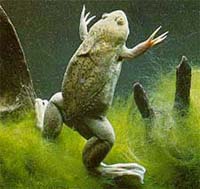Ecology, The Environment and Conservation
This complex theme deals primarily with interactions between organisms and the environmental factors that impact them, but to a greater extent between individual inanimate environmental factors.
innovations-report offers informative reports and articles on topics such as climate protection, landscape conservation, ecological systems, wildlife and nature parks and ecosystem efficiency and balance.

Discarded human debris threatens global biodiversity
Discarded human debris is encouraging colonization of exotic marine animals in the world`s oceans and threatening global biodiversity, particularly in the Southern Ocean. The findings, reported in this week`s NATURE, are based on a 10-year study of human litter (mostly plastic) washed ashore on 30 remote islands around the globe, from the Arctic to the Antarctic.
David Barnes of the British Antarctic Survey (BAS) found that man-made rubbish in the seas, especially plastics, has almost double

Discovery of method to combat toxic algal blooms and description of a new group of organisms
In the fall of 1997 a then unknown species of plankton, Parvilucifera infectans , was discovered in the Gullmar Fjord, on the west coast of Sweden. The organism is a parasite that infects and kills several species of toxic algae. Some of these toxic algae can generate extremely potent blooms at great cost to fisheries and the tourism industry around the world. Other species cause mussel toxins that cause major problems for mussel farmers in Sweden and elsewhere.
Fredrik Norén at Götebo

Gorillas to be guarded from orbit
A joint ESA and UNESCO scheme to keep watch on endangered gorilla habitats from space is the subject of a two-day ESRIN workshop this week.
Representatives of UNESCO (United Nations Educational, Scientific and Cultural Organization), the World Wildlife Fund, the International Gorilla Conservation Fund and the Dian Fossey Gorilla Fund International and United Nations Environment Programme are among those who will attend the meeting in Frascati near Rome to discuss possible partnership and agr

Common Weed Killer Disrupts Frog’s Sexual Development
Exposure to less than one part per billion of the most commonly used herbicide in the U.S. can feminize male frogs, according to a new study. The findings, published today in the Proceedings of the National Academy of Sciences, suggest that concentrations of chemicals considered safe for humans can have insidious effects on amphibians and could be contributing to the global decline in their populations.
Tyrone B. Hayes of the University of California, Berkeley, and colleagues studied the ef

World first in satellite-based monitoring of large lake areas
Satellite sensors operating in the visible wavelength region are now in use for the monitoring of oceanic waters.
For the first time ever, Finnish scientists have demonstrated the practical usability of satellite data for the simultaneous monitoring of water quality in large lake and coastal regions. The project was carried out by the Laboratory of Space Technology of the Helsinki University of Technology in cooperation with the Finnish Environment Institute.
The attached fi

Environmental pollutants may benefit human health
Industrial pollutants such as alkylphenols and PCBs have controversially been linked with hormone-dependent cancers, whilst plant chemicals known as phytoestrogens have been marketed as health supplements. But scientists are now suggesting that the story is not quite so simple.
Dr Chris Kirk and colleagues from the University of Birmingham haves been studying industrial oestrogens such as PCBs, insecticides and alkylphenols and a group of chemicals termed ‘phytoestrogens’, commonly found in